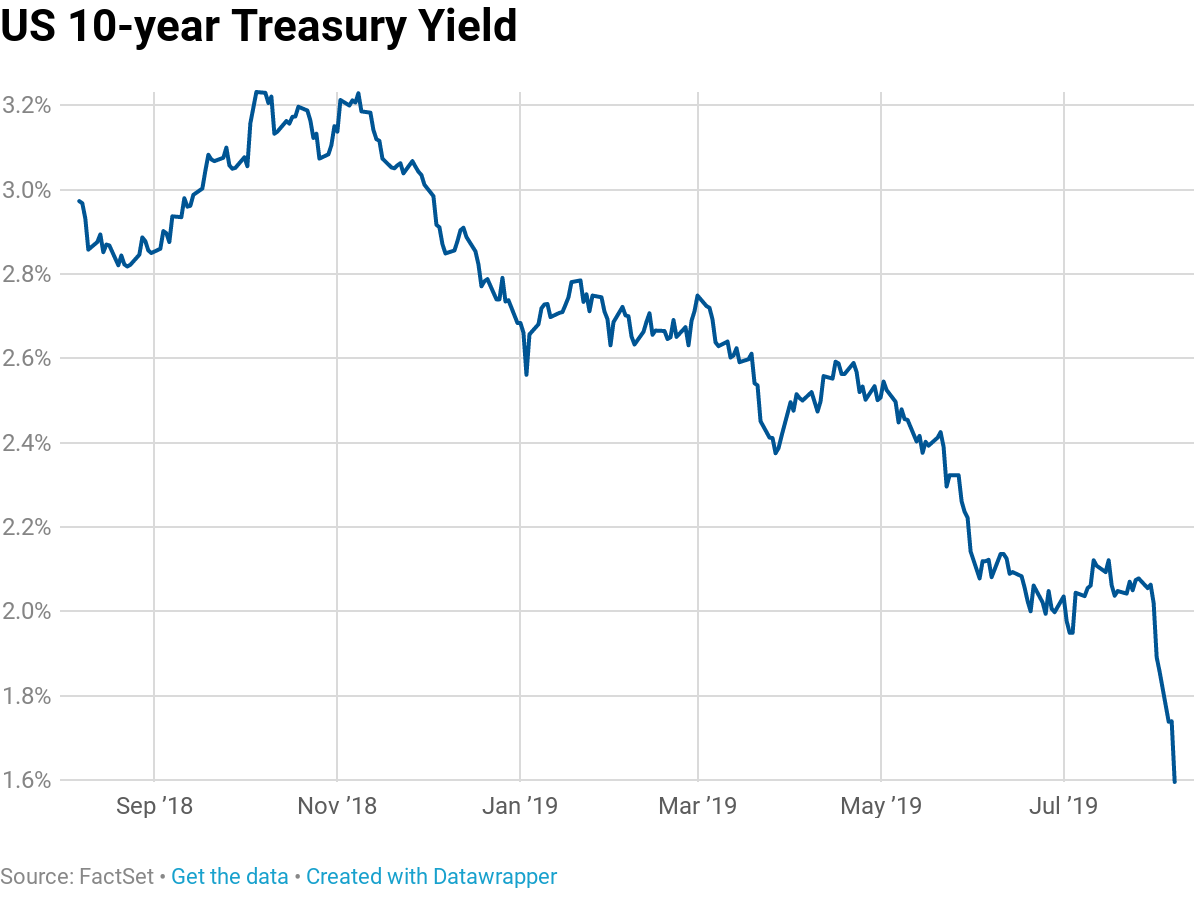- GOLD IRA
- Download Our 2024 Precious Metals IRA Investor’s Guide.
Click Here  Gold IRA
Gold IRA
 Investing
Investing
-
- CRYPTO IRA
- PRICES & STATS
- RETIREMENT PLANS
- BLOG
 Questions? Call (888) 820 1042
Questions? Call (888) 820 1042
Rate Cuts in the U.S. and Internationally a Reaction to Slowing Economy
Disclosure: Our content does not constitute financial advice. Speak to your financial advisor. We may earn money from companies reviewed. Learn more
Last Updated on: 30th August 2019, 04:00 pm

Last week saw the Federal Reserve cut interest rates for the first time since 2008. It was not solely a U.S. action. This week so far, New Zealand, India, and Thailand have also slashed their interest rates more than expected. Central banks at last have begun to admit that the global economy is in slowdown mode. The question now is: with the trade war and decelerating worldwide economy, will this remedy be enough to stave off another international recession?
U.S. Rate Cut Impacts Markets Last Week
Last Wednesday, the Federal Reserve took a major step in cutting its benchmark interest rate by .25 basis points. They claimed to be targeting problems that are not currently present but could be in coming months. The rate cut was all the more significant as it represented the first such policy move by the U.S. central bank in over a decade (dating back to 2008).
The rate cut followed nine rate increases over the last few years. With this cut, the Federal Open Market Committee brought down the rate target to from two percent to 2.25 percent. You can see the impact this has had on 10 year U.S. Treasury yields in the chart below:

The Fed gave its reasoning for the interest rate cut in their statement with:
“Implications of global development for the economic outlook as well as muted inflation pressures.”
Even though the Fed referred to the economy's present state as one of “moderate” growth with a “strong” labor market, they opted to reduce the interest rates in a policy loosening move. They also kept the possibility for additional future rate cuts open with their line that they will “act as appropriate to sustain the expansion” while they are considering data that comes in. Global Chief Investment Officer Mark Haefele of UBS Wealth Management explained their move as:
“There's a range of things that they're looking at. Really, the low inflation allows the Fed some latitude to take preemptive steps and hopefully avoid moving in the future to something like negative rates. Because they did only 25 basis points, they avoided doing what some would have felt was more shock and awe with 50 basis points. So they can move towards language like ‘data dependent' now that they've shown they are prepared to be flexible.”
Policy makers called business investment “soft” while claiming that consumer spending had “picked up from earlier in the year.”
This rate cut was the first one going back to December 16th of 2008. At that time, the American economy was in the grips of a Global Financial Crisis that threatened the entire world economy. This is when the U.S. policy makers gave in to a sense of desperation and slashed the rates from the then-current one percent down to a range of zero percent to .25 percent.
Rates stayed at that low level for an incredible seven years. This created a cheap and easy money effect that allowed for new bubbles to be blown up across asset classes in what some economists have referred to as the “everything bubble” of today.
U.S. Central Bank Cuts Bond Reduction Policy Early
In a show of the Fed's concern, they did more than just cut rates last week. They ended two months early their bond reduction from the U.S. central bank's balance sheet. This had been another effort directed at jump starting the stricken U.S. economy. The Fed had engaged in three separate rounds of buying both Treasuries and mortgage backed securities. This subsequently called quantitative easing ballooned the Fed's balance sheet to over $4.5 trillion at its peak.
It was only in October of 2017 that the Fed committee started to gradually decrease their swollen bond portfolio's size. They did this through permitting a certain amount of the proceeds from maturing securities to roll off (and reinvested the remainder). The program was scheduled to stop in September, but the Fed opted to cut it two months earlier in another sign that they are concerned about headwinds facing the economy. All proceeds from maturing securities are now being reinvested.
The problem is that the Fed did not get close to bringing its balance sheet down to its historically normal under a trillion dollars. The total reduction amounted to $618 billion bringing them down to a still enormous $3.6 trillion in holdings. This is far over what the majority of market participants and Fed officials had expected when they completed the roll off program. Prior Fed Chair Janet Yellen had claimed that this program would be as easy as “watching paint dry.”
What actually happened was quite different. The Fed's ending of quantitative easing and their nine interest rate hikes from December of 2015 have proved to cause more disruption than officials at the Fed had expected. Proof of this came in occasional market tantrums, like when current Fed Chairman Powell claimed that the reduction of the balance sheet program remained on “autopilot.”
Other Central Banks Slash Rates More than Expected
It was not just the United States taking action against troubling economic data. This week also saw the three central banks of New Zealand, India, and Thailand reveal bigger than anticipated interest rate cuts. It only confirmed the worldwide trend towards easing monetary policy on a large scale.
New Zealand surprised markets by its 50 basis points cut. Its new cash rates are now at a historic low of just one percent. This was two times as steep a cut as market observers had anticipated. Neighboring Australia's Reserve Bank of Australia kept rates at their all time low reached with their two cuts in June and July.
Meanwhile India reduced interest rates by another 35 basis points. This was their fourth consecutive cut of 2019. The Bank of Thailand also surprised by cutting its rates by 25 basis points. It was their first reduction dating back to 2015.
European Central Bank Talking About Cutting Interest Rates Too
Thanks to all of these combined rate cuts, the global longer term interest rates have dropped to all time lows, even a decade after the Global Financial Crisis. The European Central Bank has not recently cut its rates, but it is dropping hints of a reduction later in 2019. Economists believe the ECB will cut rates in September.
The ECB has referenced several concerns for their likely upcoming monetary easing. They worry about declining expectations and annual growth rates, softening outlooks domestically, and weakening consumer and business confidence. Senior Fixed Income Portfolio Manager Rabbani Wahhab of London & Capital warned that:
“The common worry among global central bankers is disinflation, which in itself is often a precursor to slowing economic activity. This is the reason why we are likely to see more central banks move over the course of the next few weeks.”
The key thing to remember from all of the central bank easing underway is that the policy makers are showing real worries about the future outlook of economic growth. In their desperation to avoid another downturn, they are using sharp monetary policy tools. Such actions from the central banks (like slashing interest rates in the current economic climate) are intended to further increase the economy's money supply while increasing demand and giving a push to flagging growth.
Unfortunately, this week's economic news is a reminder of why gold makes sense in an IRA. One way to diversify effectively from holding mostly stocks is to add some IRA-approved precious metals to your retirement portfolio. You can get some ideas by looking at the top five gold coins for investors and the top gold IRA companies and bullion dealers.



 Silver
Silver Gold
Gold Platinum
Platinum Palladium
Palladium Bitcoin
Bitcoin Ethereum
Ethereum

 Gold: $2,387.15
Gold: $2,387.15
 Silver: $27.92
Silver: $27.92
 Platinum: $931.02
Platinum: $931.02
 Palladium: $903.43
Palladium: $903.43
 Bitcoin: $67,910.26
Bitcoin: $67,910.26
 Ethereum: $3,278.81
Ethereum: $3,278.81